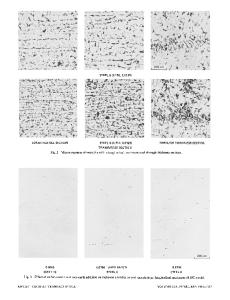Effects of dynamic strain aging on the subsequent mechanical properties of carbon steels
- PDF / 929,987 Bytes
- 11 Pages / 613 x 788.28 pts Page_size
- 38 Downloads / 365 Views
1008
1020
1522
1035
LYS
50 to 60 ksi (345 to 415 MPa)
72 to 85 ksi (500 to 585 MPa)
71 to 84 ksi (490 to 579 MPa)
80 to 95 ksi (550 to 655 MPa)
UTS
58 to 65 ksi (400 to 450 MPa)
80 to 86 ksi (550 to 595 MPa)
79 to 87 ksi (545 to 600 MPa)
90 to 95 ksi (620 to 655 MPa)
15 to 20
10 to 15
15 to 20
6 to 8
Elongation in 25 mm, pct
I. INTRODUCTION
r e s u l t s obtained f r o m the study of the B a u s c h i n g e r e f fect have been r e p o r t e d , n
THE
rising costs of alloying elements for steels and the inevitable depletion of these elements in the earth's crust z make it imperative for us to evaluate all strengthening mechanisms for steels that do not depend upon alloying. One such mechanism is dynamic strain aging. The physical manifestations of dynamic strain aging in steels are serrated flow curves, high work-hardening rates, negative or zero strain-rate sensitivity, pronouncedstrengthening and reduction of ductility.2 Through numerous studies these phenomena are now well understood, but the application of dynamic strain aging has not been wide spread. In part, this may be due to a lack of knowledge of the interrelated effects of steel compositionand the temperature, strain and strainrate at which the operation is conducted. This information is necessary for the proper design of a facility employingdynamic strain aging, such as a device for the warm straightening of bars on the coolingbed of a bar mill. A number of studies of dynamic strain aging of commercial steels have been reported, 3-I~with the m a j o r w o r k b ei n g that of M a r k u l a and Heiskanen.3 H o w e v e r , a l l of t h e s e w e r e d e f i c i e n t in c o v e r a g e of steel composition, temperature, strain, strain rate and m e c h a n i c a l p r o p e r t i e s m e a s u r e d . T h e r e f o r e , the p u r p o s e s of this study w e r e 1) to i n v e s t i g a t e the eff e c t s of d y n a m i c s t r a i n aging on the s u b s e q u e n t r o o m t e m p e r a t u r e p r o p e r t i e s of s e v e r a l c o m m o n l y used c a r b o n s t e e l s and 2) to e s t a b l i s h the o p e r a t i n g l i m i t s f o r c o m m e r c i a l p r a c t i c e . Changes in t e n s i l e p r o p e r t i e s , fatigue life, n o t c h - i m p a c t t r a n s i t i o n t e m p e r a t u r e and B a u s c h i n g e r e f f e c t w e r e d e t e r m i n e d . Th e C.-C. LI is with General Atomic Company, San Diego, CA 92138 and W. C. LESLIE is Professor, Department of Materials and Metallurgical Engineering, University of Michigan, Ann Arbor, MI 48109. Manuscript submitted November 14, 1977. METALLURGICALTRANSACTIONS A
II. M A T E R I A L S Commercially available semi-killed, silicon-killed and s i l i c o n - a l u m i n u m k i l l e d c a r b o n s t e e l s , AISI 1008, 1020 and 1035, w e r e used. Th e carbon contents r a n g e d f r o m 0.07 to 0.34 wt pct, the r an g e of w i d e s t c o m m e r c i a l a p p l i c a t i o n . To obtain an i n d i c a t i o n of the e f f e c t s of n i t r o g e n and m a n g a n e
Data Loading...











